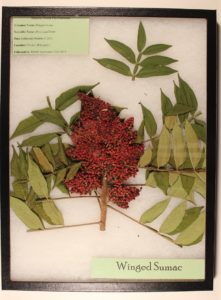| Common Name(s) | Winged Sumac | ||||
| Scientific Name | Rhus copallina | ||||
| Family | Anacardiaceae | ||||
| Location/Vegetative Zone | Edge | ||||
| Flowering Period | Spring-Early Fall | ||||
| Identifying Characteristics | Central leaf stalks and wings | ||||
Description
The winged sumac usually grows up to ten feet tall. The leaves are narrowed or rounded at the base and sharply pointed at the tip with finely serrated margins. The foliage turns red during the fall. The flowers on the plant grow in clusters and are greenish-yellow in color.
Location
Eastern U.S. from Maine, west to Michigan, south to Texas and Florida; All are tolerant of slightly acid soil conditions and textures ranging from coarse to fine. Typical growing sites include open fields and roadsides, fence rows, railroad rights-of-way, and burned areas. Sumacs are not highly shade tolerate and are considered early successional species.
Uses
- Winter “emergency food” for wildlife
Misc
- The germination of sumac seeds is enhanced by their passage through the digestive system of rabbits, ring-necked pheasants, and quail. The presence of fire also encourages increased germination.
- Ring-necked pheasant, bobwhite quail, wild turkey, and about 300 species of songbirds include sumac fruit in their diet.
2,641 total views, 1 views today

